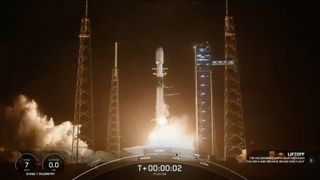An eerie, blood-red orb of light was recently photographed in the night sky above Texas after SpaceX launched a satellite-laden rocket into space. The increasingly common phenomenon, known as a “SpaceX aurora,” was the result of an atmospheric hole that was ripped open by the dying rocket.
On April 10, photographer Abdur Anwar spotted the bright light at around 3:15 a.m. EDT above Big Bend National Park in southern Texas. The light quickly faded out of view from the naked eye. But using a smartphone camera, Anwar was able to take a long-exposure image that captured the faint blob before it disappeared completely. However, he “couldn’t explain” what it was, according to his Instagram post.
What Anwar managed to capture was the tail end of an aurora-like phenomenon that was triggered by a hole in the ionosphere — the upper part of the atmosphere between 50 and 370 miles (80 and 600 kilometers) above the Earth’s surface where gases are turned into plasma by solar radiation. But this hole was not a natural occurrence. Instead, it was birthed by one of SpaceX’s Falcon 9 rockets falling back to Earth, according to Spaceweather.com.
The rocket, which was carrying 23 Starlink satellites, launched from the Cape Canaveral Space Force Station in Florida at around 1:40 a.m. EDT — around 90 minutes before Anwar spotted the light, Live Science’s sister site Space.com reported.
After separating from the rocket’s reusable booster, the rest of the spacecraft deployed the satellites into low-Earth orbit. Then, the now-defunct rocket began a deorbit burn to land in the Pacific Ocean, according to Spaceweather.com. This was done to minimize the amount of space junk in orbit around our planet.
During the deorbit burn, the rocket released water and carbon dioxide into the atmosphere, which reacted with ionized oxygen atoms to create regular oxygen, temporarily reducing the amount of plasma in the ionosphere. This transformation excites these molecules and causes them to emit light as a result. The light has the same red wavelength as auroras given off by oxygen atoms but quickly disappears as the molecules reionize.
Related: Oops! US Space Force may have accidentally punched a hole in the upper atmosphere
This phenomenon is becoming increasingly common,…
Click Here to Read the Full Original Article at Livescience…

